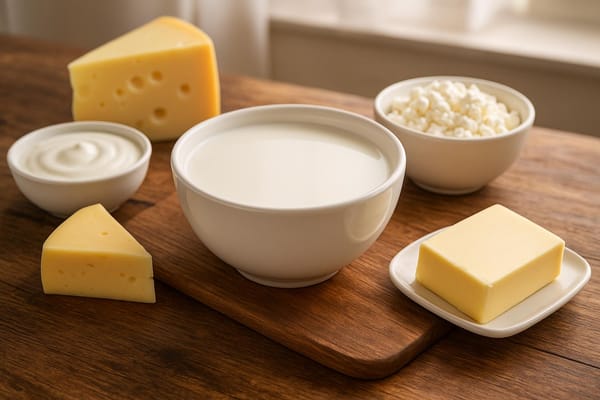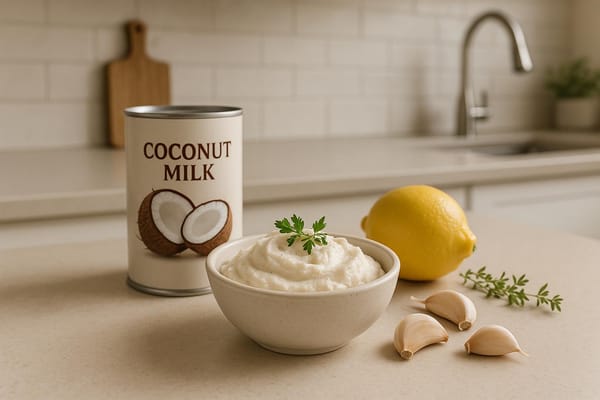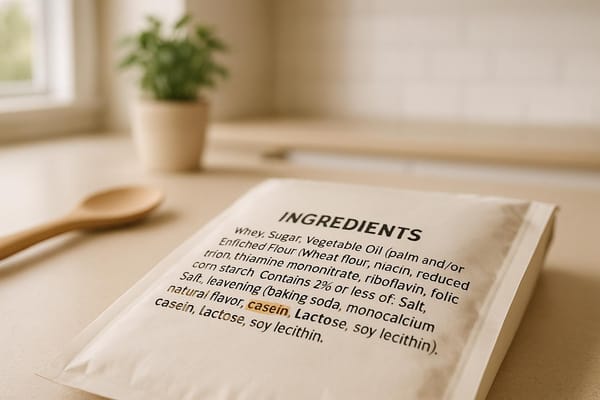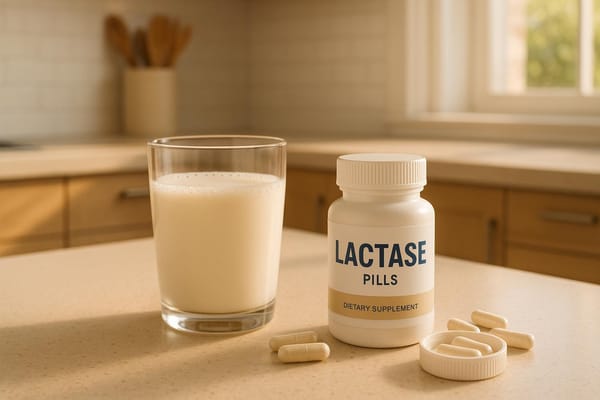Ultimate Guide to Dairy-Free Substitutes
Explore a range of dairy-free substitutes for milk, cheese, butter, and cream to maintain flavor and nutrition in your meals.
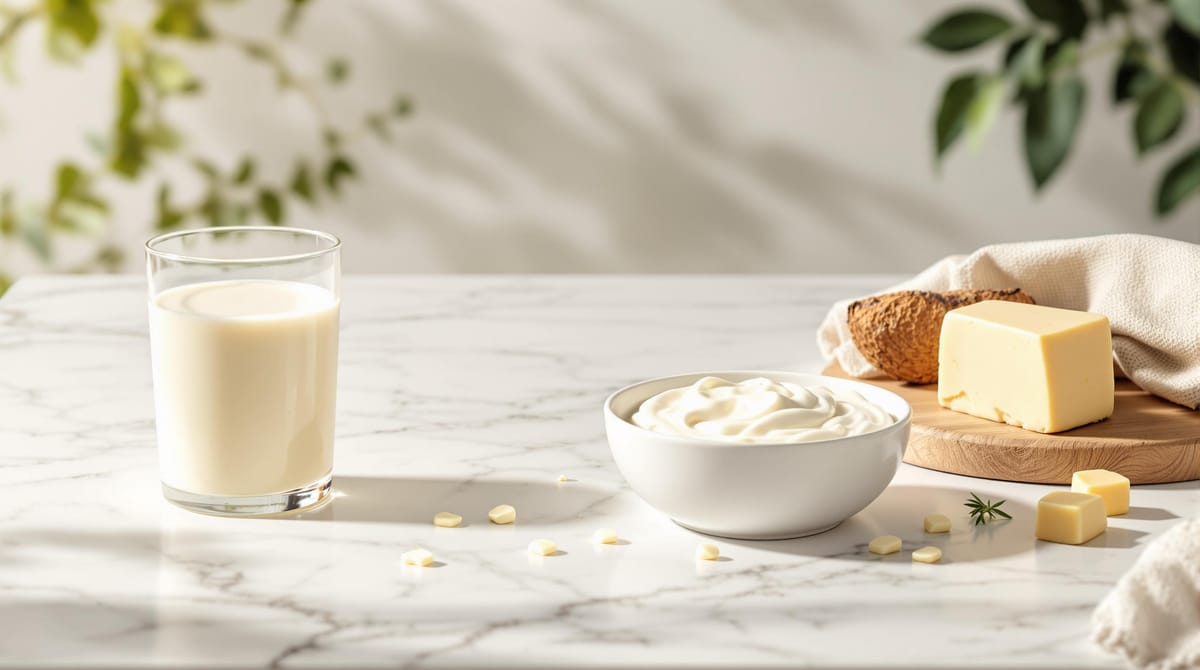
If you're avoiding dairy - whether for health, dietary, or personal reasons - this guide simplifies your options. Here's what you'll learn:
- Milk Alternatives: Almond, soy, oat, coconut, and rice milk, each suited for different uses like baking, coffee, or smoothies.
- Non-Dairy Cheese: Nut-based, soy, and coconut cheeses for spreads, melting, and cooking.
- Butter Substitutes: Coconut oil, olive oil, and vegan butter for baking and sautéing.
- Cream Replacements: Coconut, oat, and cashew creams for soups, desserts, and sauces.
- Lactase Pills: A solution for digesting dairy if you’re lactose intolerant.
Quick Comparison: Milk Alternatives
| Milk Type | Protein (per cup) | Best Uses | Key Tips |
|---|---|---|---|
| Almond | 1g | Smoothies, Baking | Reduce liquid in recipes |
| Soy | 7-8g | Cooking, Baking | Use unsweetened for savory |
| Oat | 3g | Coffee, Baking | Helps with browning in breads |
| Coconut | 0-1g | Curries, Desserts | Adjust fat content as needed |
| Rice | <1g | Cereals, Beverages | Add thickeners for cooking |
Start with these substitutes to make your meals dairy-free while maintaining flavor and texture.
7 Best Ingredients for Dairy-Free Substitutes & Cooking
Milk Substitutes
Plant-based milk options are now tailored for various uses like cooking, baking, and everyday consumption. Here's a breakdown of the most common substitutes and their best applications.
Almond Milk
Almond milk has a mild, nutty flavor and just 30-40 calories per cup in its unsweetened form. It's great for smoothies, cereals, and baked goods. Look for brands fortified with calcium and vitamin D. Its thinner texture works well in pancakes and quick breads, but you may need to reduce the liquid in recipes by about 1/4 cup per cup of milk.
Soy Milk
Soy milk provides 7-8g of protein per cup, closely resembling dairy milk. Its stable structure makes it a solid choice for high-heat cooking and baking. Plain soy milk works well in savory dishes, while vanilla-flavored varieties enhance desserts and breakfast recipes. For better control over sweetness, stick to unsweetened versions.
Oat Milk
Oat milk's creamy texture and natural sweetness are perfect for rich lattes and foamy coffee drinks. Its thickness also makes it great for baking, where its natural sugars help with browning in breads and pastries. Each cup has about 3g of protein and includes fiber, making it a nutritious option.
Coconut Milk
Coconut milk comes in two forms: canned and carton. Canned coconut milk, with 45-60% fat, is ideal for curries, soups, and ice creams. Carton versions, diluted to about 2% fat, are better for daily drinking. Its tropical flavor works in both sweet and savory recipes, though it might slightly alter the dish's taste.
Rice Milk
Rice milk has about 120 calories per cup but offers minimal protein. Its naturally sweet flavor is well-suited for cereals and smoothies. Due to its thin consistency, you may need to add a thickener like cornstarch for cooking. It's best for recipes where a light, sweet flavor is desired, such as dessert sauces or light batters.
Here's a quick comparison to help you decide:
| Milk Type | Protein per Cup | Best Uses | Cooking Tips |
|---|---|---|---|
| Almond | 1g | Smoothies, Baking | Reduce recipe liquid by 25% |
| Soy | 7-8g | General Cooking | Use unsweetened for savory dishes |
| Oat | 3g | Coffee Drinks, Baking | Great for bread browning |
| Coconut | 0-1g | Curries, Ice Cream | Choose fat % based on recipe |
| Rice | <1g | Cereals, Beverages | Add thickeners for cooking |
Non-Dairy Cheese
Once you've explored milk alternatives, it's time to dive into non-dairy cheeses. These options replicate the taste, texture, and functionality of traditional cheese, making them a great addition to a variety of dishes.
Nut Cheese
Cheeses made from nuts like cashews and almonds have a smooth, creamy texture that works well for spreads and dips. Their mild flavor makes them easy to season for different recipes. For example, cashew cheese can replace cream cheese on bagels, serve as ricotta in lasagna, act as a base for cheese sauces, or even be used in cheesecakes.
To make nut cheese at home, soak raw cashews for 4 to 8 hours to soften them. Use a high-powered blender for the smoothest consistency. Adding nutritional yeast gives it a cheesy flavor, while probiotics can create cultured varieties.
| Nut Type | Best Uses | Soaking Time | Key Additives |
|---|---|---|---|
| Cashews | Spreads, Sauces | 4-8 hours | Nutritional yeast |
| Almonds | Firm cheese | 8-12 hours | Agar agar |
| Macadamia | Soft cheese | 2-4 hours | Miso paste |
Soy Cheese
Soy-based cheeses are a great choice for recipes that need melting or stretching. Made from soy protein isolate and oils, these cheeses work well in:
- Grilled sandwiches
- Pizza toppings
- Quesadillas
- Casseroles
For the best results, shred soy cheese while it's cold. Let it sit at room temperature before using to help it melt evenly and avoid clumping.
Coconut Cheese
Cheeses made with coconut fats provide a rich, creamy texture. They're particularly effective in:
- Mac and cheese sauces
- Nacho cheese dips
- Mozzarella substitutes
- Cream cheese alternatives
When cooking with coconut cheese, use moderate heat to prevent it from separating. For baked dishes, start by covering them to ensure even melting, then uncover toward the end to allow browning.
| Application | Temperature Range | Cooking Tips |
|---|---|---|
| Baked Dishes | 350-375°F | Cover for the first 15 minutes |
| Stovetop Melting | Low-medium heat | Stir constantly |
| Broiling | 3-5 minutes max | Watch closely |
Butter Replacements
If you're cutting out dairy, finding the right butter substitute can transform your cooking and baking. Each option has its own qualities that work best in different recipes.
Coconut Oil
Coconut oil is a go-to choice, especially for recipes needing a firm, flaky texture. For a neutral flavor, use refined coconut oil. If you want a subtle coconut taste, stick with virgin coconut oil. When using it in pastry dough, make sure to chill it beforehand to keep the right consistency. Keep in mind, coconut oil behaves differently than butter, so you might need to tweak the amounts to get the perfect outcome.
Olive Oil
Olive oil is a great liquid alternative, particularly for savory dishes. Its bold flavor shines in sautéing, pan-frying, making garlic bread, or crafting sauces. If you're swapping olive oil for melted butter, adjust the measurements to suit your recipe.
Vegan Butter
Vegan butter is designed to replicate the taste and texture of dairy butter. Made from vegetable oils and emulsifiers, it’s a straightforward 1:1 replacement. Just make small adjustments for water content if needed, and use it at room temperature for the best results.
Cream Substitutes
After exploring alternatives for milk, cheese, and butter, let’s dive into cream substitutes to expand your dairy-free options. These choices work well in everything from savory sauces to sweet desserts.
Coconut Cream
Full-fat coconut cream provides a thick, rich texture. To use it, refrigerate the can overnight to separate the cream from the liquid. Whip the solidified cream into peaks for a dessert topping.
Best uses include:
- Thai curries and soups (use as a 1:1 replacement)
- Dairy-free ice cream bases
- Creamy pasta sauces
If the coconut flavor is too strong, mix it with a neutral oil-based milk like oat milk to balance it out.
Oat Cream
Oat cream comes in two varieties: one for cooking ("single") and one for desserts ("double"). It holds a smooth texture even when heated, making it a great choice for coffee, soups, sauces, and baked goods.
Add oat cream toward the end of cooking to maintain its consistency, and avoid boiling it. For baking, reduce other liquids in your recipe by 2 tablespoons for every cup of oat cream used.
Cashew Cream
Cashew cream is easy to make at home. Soak 1 cup of raw cashews in hot water for 30 minutes, drain, then blend with ½ cup water. Add more water as needed to reach your preferred consistency.
Use cashew cream in:
- Creamy pasta sauces
- Dairy-free cheesecakes
- Smooth soups
- Dips and spreads
For a smoother texture, strain the mixture through a fine-mesh sieve after blending. Store it in an airtight container in the fridge for up to 5 days.
Up next, find out how to incorporate these substitutes into recipes for consistently tasty results.
How to Cook with Dairy Substitutes
Adjust Recipe Flavors
Switching to dairy alternatives? Small tweaks can help replicate the flavors of traditional dairy. For savory dishes, try boosting umami with nutritional yeast or miso paste. A good starting point is 1 tablespoon of nutritional yeast per cup of your substitute - then adjust to your liking.
For baked goods, consider these tips:
- Add an extra ¼ teaspoon of vanilla extract when using unsweetened plant-based milk.
- Increase salt by ⅛ teaspoon per cup of your dairy alternative.
- Add 1 teaspoon of apple cider vinegar per cup to mimic the tang of buttermilk.
These simple changes make it easier to blend dairy substitutes into your favorite recipes.
Read Product Labels
Not all dairy substitutes work the same way in cooking. Pay attention to these key factors:
- Fat content: Look for 3-4g of fat per serving for milk substitutes used in cooking.
- Stabilizers: Ingredients like gellan gum or carrageenan help with heat stability.
- Sugar content: Unsweetened options are best for savory dishes.
- Protein content: Higher-protein options like soy milk perform better in baking.
Make Your Own
Want full control over your dairy substitute? Making your own is simple. For a basic milk alternative, use 1 cup of nuts to 4 cups of water (or 2 cups of water for cooking). Soak the nuts for 4–8 hours (soft varieties) or 8–12 hours (harder types), blend on high for 2–3 minutes, and store in an airtight container in the fridge for 3–5 days.
If you need a thicker option, like cream, cut the water in half. For a creamier texture, add 1 tablespoon of neutral oil (such as sunflower or grapeseed) per cup of nuts. This small addition improves both texture and mouthfeel.
Using Lactase Pills
If you enjoy traditional dairy but struggle with digestion, enzyme supplements can help. These supplements provide the enzymes your body may need to process dairy more comfortably.
Dairy digestion relies on three key enzymes:
- Lactase: Breaks down lactose (milk sugar)
- Protease: Processes casein (milk protein)
- Lipase: Helps digest milk fats
milktab Triple-Enzyme Pills

milktab offers a triple-enzyme pill designed to aid dairy digestion. Each pill contains:
| Enzyme Type | Amount (FCC Units) | Function |
|---|---|---|
| Lactase | 27,000 | Breaks down lactose |
| Protease | 22,000 | Breaks down casein |
| Lipase | 1,000 | Processes milk fats |
These pills are vegan, non-GMO, and FODMAP-free, catering to a variety of dietary needs. For the best results, take up to two pills daily.
This formula allows you to enjoy traditional dairy with less worry about digestive discomfort.
Summary
This guide provides detailed profiles and practical advice to support your dairy-free lifestyle. We've covered a range of options, including milk alternatives, cheese substitutes, butter replacements, and cream options, offering solutions to fit your needs.
For those who enjoy traditional dairy but experience digestive issues, enzyme supplements like milktab can help. As one user puts it:
Best on the market!! With Milktab, I don't have to worry about the pill not working because of how strong it is!
When deciding between dairy alternatives and traditional dairy products, it’s important to think about how each option performs in cooking and its nutritional content. Whether you opt for plant-based substitutes or enzyme supplements, you can still enjoy your favorite recipes without discomfort.
With the variety of options and strategies outlined here, you’ll be able to make choices that suit your dietary needs and preferences, ensuring a delicious and enjoyable experience - whether you’re cooking, baking, or savoring your morning coffee.
